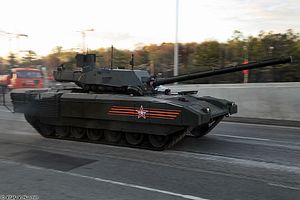Russia’s deadliest tank, the third-generation T-14 main battle tank (MBT), an armored vehicle based on the “Armata” universal chassis system, might be getting even more deadly in the near future.
According to unconfirmed media reports, Russian defense contractor Uralvagonzavod (UVZ), the world’s largest tank maker, will not only upgrade later versions of the mysterious T-14 with a new 2A83 152 millimeter gun but also develop a nuclear tank shell for tactical use on the battlefield.
It is unclear whether a 152 millimeter sub-kiloton low-yield round is already under development. The use of tactical nuclear weapons on the battlefield is not part of official Russian military doctrine. However, Russia has made important strides in low-fission, high-fusion, sub kiloton tactical nuclear technology in recent years.
Nevertheless, it is more than unlikely that Russia will arm the T-14 with nuclear shells given the short range of the MBTs gun. The current version of the T-14 is armed with the 2A82 125 millimeter smoothbore cannon, capable of firing high-powered munitions (10 shots a minute at an effective range of up to seven kilometers). The 2A83 152 millimeter gun would have a much lower rate of fire.
At the end, the Russian military would do better to arm the T-14 with depleted uranium shells rather than nuclear weapons in order to maximize the tank’s fire power on the tactical battlefield.
The Armata is the first new MBT developed by Russia after the collapse of the Soviet Union. The tank is reportedly fitted with a new active protection system including a new generation of explosive reactive armor allegedly capable of fending off the world’s most advanced anti-tank gun shells and anti-tank missiles.
Furthermore, as I pointed out elsewhere (See: “Russia’s Military to Receive 100 New T-14 Armata Battle Tanks”), the T-14 will eventually be a completely automated combat vehicle, remotely controlled and fitted with a unmanned turret. The T-14’s genuine combat capabilities are unknown, and will remain so until tested in actual combat. As of now, no T-14 MBT has been spotted in eastern Ukraine.
“The Armata universal chassis system is a platform for over a dozen different tracked vehicles, including a self-propelled artillery gun, an armored military engineering vehicle, and an armored personal carrier,” I explained elsewhere. “70 percent of tracked armored vehicles of the Russian Ground Forces are slated to be replaced by vehicles based on the Armata universal chassis system.”
In 2016, Russia Ministry of Defense ordered a first batch of 100 T-14s and purportedly intends to procure up to 2,300 T-14s by 2025. It appears, however, that this is far beyond the financial and production capacity of Russia. According to some estimates, Russia is only capable of building 120 new T-14s per year from 2018. There are currently around 20 T-14s prototypes operating with the Russian Ground Forces. It is unclear whether the tank has already entered serial production.

































